Guide to Power Outlets and Plugs Around the World: What Travelers Should Know
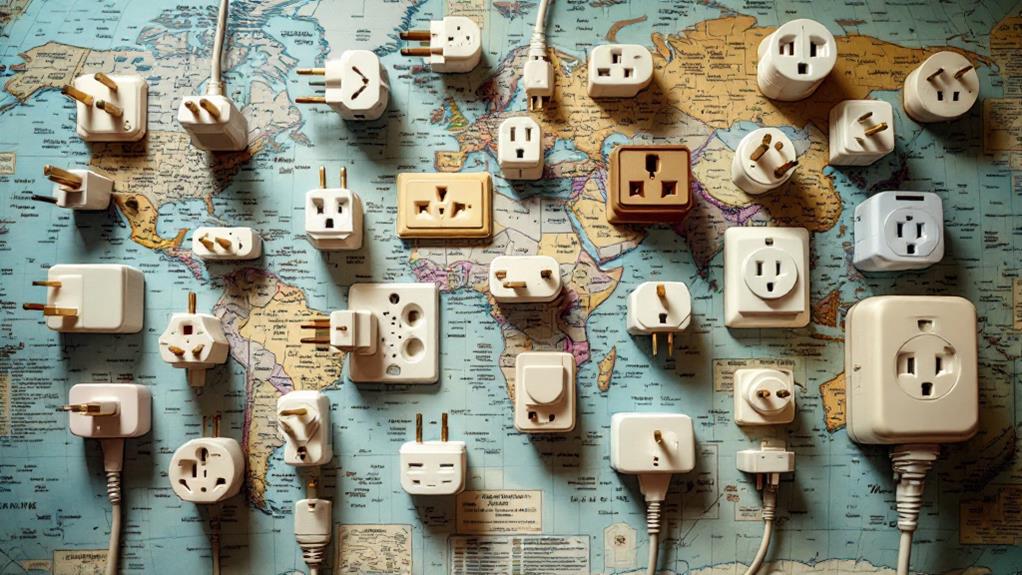
When you're traveling internationally, it's essential to understand the diverse power outlets and plug types worldwide. You'll encounter about 15 distinct plug types, like Type A and B in North America, Type C in Europe and Asia, and Type G in the UK. Voltage can differ, too, with systems operating either on 110-120V or 220-240V. Always carry a universal adapter to fit different plugs and make certain your devices are compatible with the local voltage to avoid mishaps. Staying informed about these details can save you from unexpected surprises and prepare you thoroughly for your expedition.
Common Plug Types Worldwide
When you travel internationally, it's vital to know about the different plug types you'll encounter. Plug compatibility is a key travel necessity, guaranteeing that your devices stay charged and ready to go. Around the world, there are about 15 different plug types, each with unique shapes and configurations. For example, Type A and B plugs are common in North and Central America, with flat parallel pins. In contrast, Type C, a two-round-pin plug, is widely used across Europe and Asia, making it one of the most common globally.
Before you pack your bags, check the plug type used in your destination. It's a simple step that saves you a lot of hassle. For instance, if you're heading to the UK, you'll need a Type G plug adapter with three rectangular prongs. Having the right adapters guarantees your devices will work without a hitch.
A universal adapter can be a lifesaver, offering compatibility with multiple plug types. It's small, portable, and a must-have item in your travel essentials kit. Remember, understanding plug compatibility is vital for a smooth travel experience. Make sure you're prepared, and you'll avoid unnecessary headaches on your expedition.
Voltage Differences by Country
Understanding voltage differences by country is crucial for any international traveler. When you're on the move, knowing the voltage standards in your destination can help you avoid mishaps with your electronic devices. Most countries operate on either 110-120V or 220-240V systems, and plugging a device into the wrong voltage can damage it or even cause a safety hazard.
If you're traveling to countries like the United States, Canada, or Japan, expect a voltage standard of around 110-120V. Meanwhile, Europe, Australia, and most parts of Asia and Africa use a higher voltage standard of 220-240V. Confirming electrical compatibility means checking your devices' voltage ratings. Many modern electronics, like laptops and phone chargers, are dual voltage, supporting both ranges. If your device isn't dual voltage, using it in a country with different standards can lead to overheating or failure.
To guarantee your electronics work safely, identify the voltage requirements of your devices before you travel. This proactive step will help protect your gadgets from damage and keep your trip trouble-free. Remember, being aware of voltage differences by country is not just about convenience; it's about keeping your devices and yourself safe.
Adapters and Converters Explained
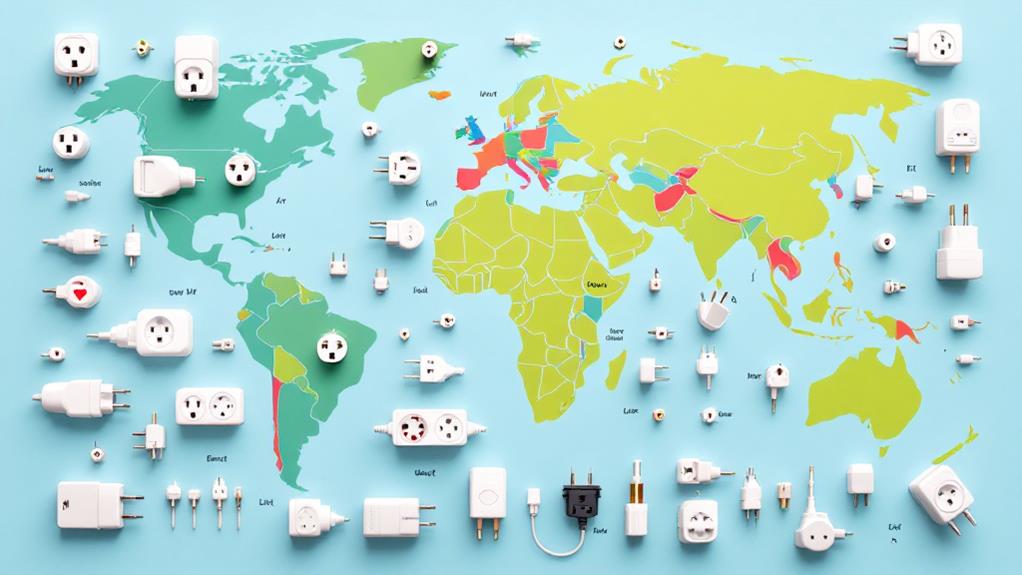
Having grasped the significance of voltage differences, you'll now want to secure your devices can connect safely and efficiently in foreign outlets. Adapters and converters are your best friends in this mission. Adapters allow your device's plug to fit into a foreign outlet. They're vital when the plug shape doesn't match the outlet. Numerous adapter types exist to suit different plug shapes and socket configurations around the world. Remember, adapters don't convert voltage; they solely change the plug shape.
Converters, on the other hand, tackle voltage differences. If your device isn't dual-voltage, you'll need a converter to transform the electrical current from the outlet to match your device's requirements. Converter uses are imperative for high-power appliances like hair dryers or electric kettles. Be mindful, though, converters are generally not recommended for prolonged use with sensitive electronics like laptops or smartphones.
When preparing for travel, check the electrical specs for your devices and the destination's power standards. Ascertain you have the right adapter and, if necessary, the correct converter. This careful planning prevents damage to your electronics and guarantees they function seamlessly wherever you go.
Regions With Type a and B Plugs
Although traveling can be exciting, navigating through the world of power outlets requires some know-how, especially in regions using Type A and B plugs. You'll find these plug types mainly in North America, including the United States and Canada, along with Japan and parts of Central America. Type A plugs have two flat parallel pins, while Type B plugs include a grounding pin, making them a bit safer for plugging in heavy-duty devices.
Before you jet off, confirm your travel necessities include the right plug adapters for these regions. Plug compatibility is vital, especially since different countries may use the same plug types but operate on different voltages. The U.S. and Canada usually run on 120V, while Japan operates on both 100V and 50/60Hz. Plugging your devices into an incompatible outlet without proper adaptation can lead to damage.
To avoid surprises, always check the voltage requirements of your devices and carry a universal adapter if you're visiting multiple countries. In regions with Type A and B plugs, being prepared guarantees you can keep your gadgets charged and ready, making your trip smoother and more enjoyable.
Navigating Type C and F Outlets
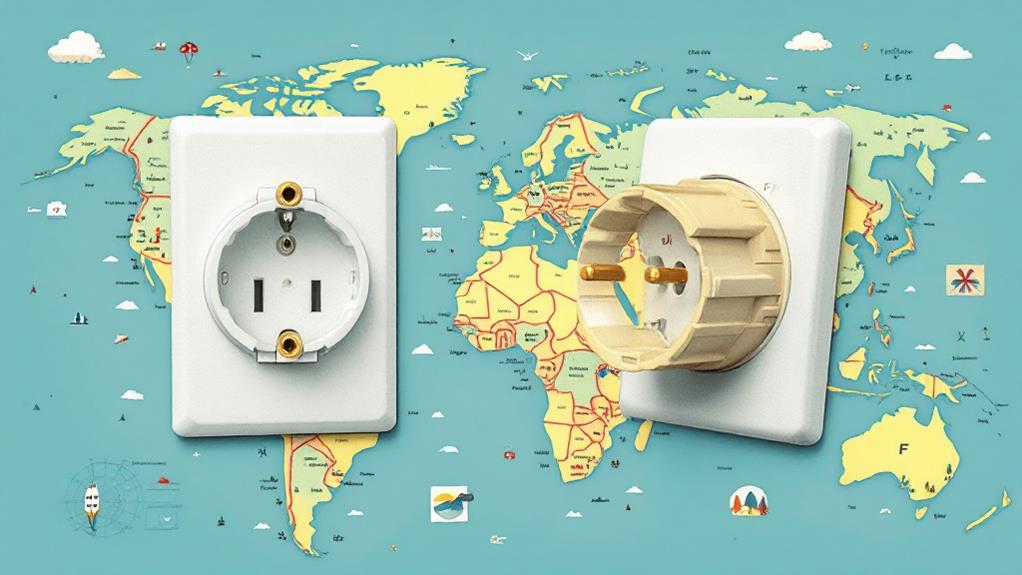
Now that you're familiar with Type A and B plugs, it's time to investigate the world of Type C and F outlets, commonly found in Europe and parts of Asia. Type C outlets, known for their two round prongs, are quite prevalent. They're particularly popular due to their simplicity and the ability to accommodate a variety of plug types. You'll find Type C usage primarily in devices that don't require grounding, such as phone chargers and small electronics. Just remember, Type C outlets operate on 220-240 volts, so make certain your devices are compatible or have a voltage converter handy.
On the other hand, Type F outlets, or "Schuko" plugs, are similar to Type C but include grounding. They feature two round prongs and two earthing clips on the side. This makes Type F compatibility vital for larger appliances like refrigerators and washing machines. Type F outlets are designed for safety, offering a secure connection that minimizes the risk of electrical shock. Like Type C, they also operate at 220-240 volts. When traveling, carrying a universal adapter guarantees you're prepared for both Type C and F outlets, keeping your devices powered without a hitch.
Countries Using Type G and I Plugs
When you travel to different parts of the world, you'll encounter a variety of plug types, including the distinct Type G and I plugs. If you're visiting the United Kingdom, you'll need to familiarize yourself with the UK plug characteristics. Type G plugs are commonly used and feature three rectangular prongs in a triangular pattern. They're grounded and come with a fuse, guaranteeing safety with a higher voltage supply of 230V. These plugs are bulky compared to others, so make certain your adapter fits snugly.
On the other hand, the Type I plug is prevalent in Australia. Australian plug features include two flat prongs forming an inverted V and a grounding pin. These are typically used with a 230V supply, similar to Type G. Confirm your devices are compatible with this voltage to avoid mishaps. Type I plugs are also found in other countries like New Zealand and Papua New Guinea.
As you plan your travels, keep in mind that carrying a universal adapter can save you the trouble of hunting for local adapters. Always check your device specifications for voltage compatibility to prevent any damage. With this knowledge, you'll stay powered up on your adventures!
Type D and M Plug Destinations
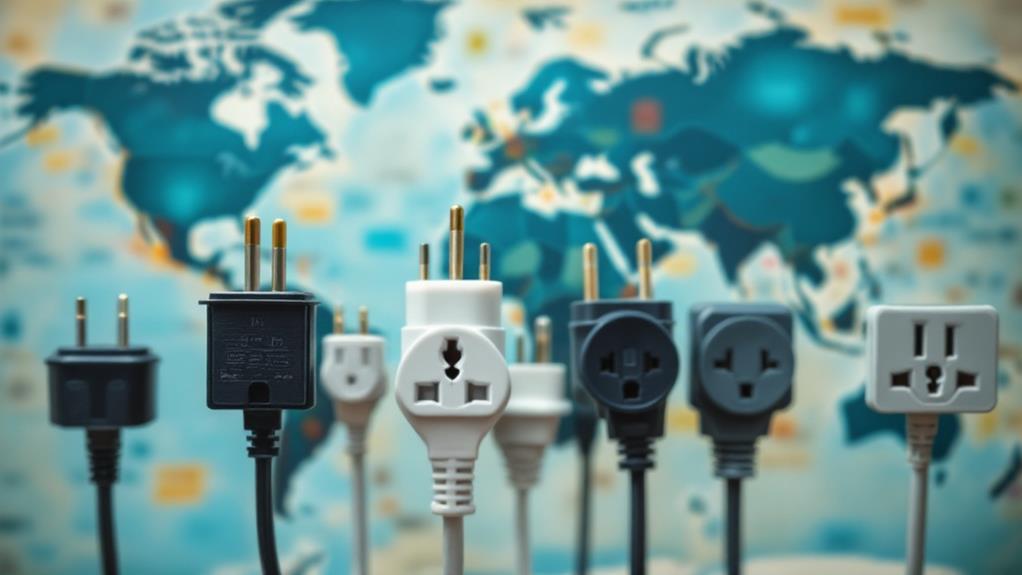
If you're venturing into parts of Africa or Asia, you'll likely encounter Type D and M plugs. Type D destinations are prevalent in countries like India, Nepal, and Sri Lanka. This plug type features three large, round pins in a triangular formation. You'll find it commonly used in older installations, so it's prudent to pack the right adapter when visiting these regions. The Type D plug is not only found in South Asia but also in a few African nations like Namibia and Zimbabwe.
Type M usage is often seen in South Africa, Swaziland, and Lesotho. This plug is similar to Type D but larger, with three round pins arranged in a triangle. While Type M isn't as widespread as Type D, it's crucial to be prepared if your travels lead you to these destinations. It's primarily used for larger appliances, but some regions may still use it for general electrical outlets, especially in older buildings.
Before you set off, verify your travel adapter accommodates both Type D and M plugs. This preparation guarantees your devices stay powered, letting you focus on enjoying your trip without connectivity issues.
Safety Tips for Electrical Devices
While ensuring you have the correct adapters for Type D and M plugs, don't overlook the importance of electrical safety. When traveling, your devices face unique challenges, such as different voltage and frequency standards. Without proper precautions, you risk damaging your gadgets or even worse, creating a safety hazard. To keep your devices safe, consider several key safety tips.
- Surge Protection: Use a travel-sized surge protector to safeguard your devices against unexpected voltage spikes. This is especially vital in areas where power supply stability is questionable.
- Device Compatibility: Before plugging in, verify that your device is compatible with the local voltage and frequency. Most modern electronics are dual voltage, but always double-check to avoid potential damage.
- Inspect Adapters: Regularly inspect your adapters for wear and tear. Damaged equipment can cause shorts or electrical shocks, so replace any faulty items immediately.
- Avoid Overloading: Don't overload power strips or outlets. Plugging too many devices can lead to overheating and potential fire hazards.
Purchasing Universal Plug Adapters
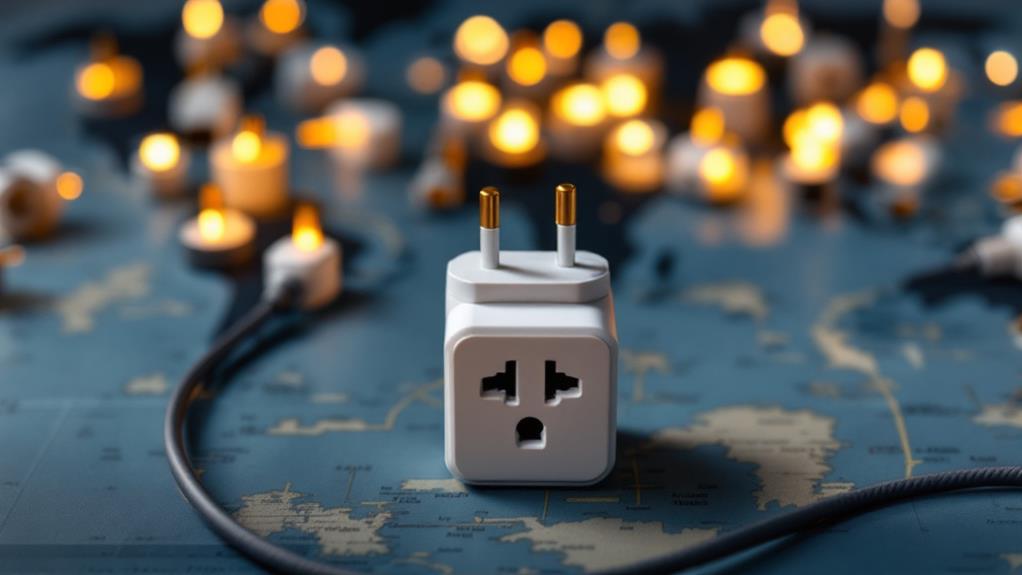
How do you guarantee seamless connectivity for your devices when traveling across different countries? The answer lies in purchasing a universal plug adapter. These handy devices are vital for any traveler, making certain your gadgets stay powered no matter the destination. When choosing one, pay attention to universal adapter features. Look for adapters that support multiple plug types (A, B, C, D, etc.), as these are compatible with outlets in diverse countries. Moreover, some adapters come with USB ports, which can be incredibly useful for charging smartphones and tablets without needing extra plug sockets.
It's also important to evaluate cost effective options. While it might be tempting to go for the cheapest model, verify it meets your needs regarding plug compatibility and voltage conversion. Some adapters only change the plug shape without converting voltage, a significant feature if your devices aren't dual voltage. Read reviews and do a bit of research to find reliable brands that offer good value for money.



